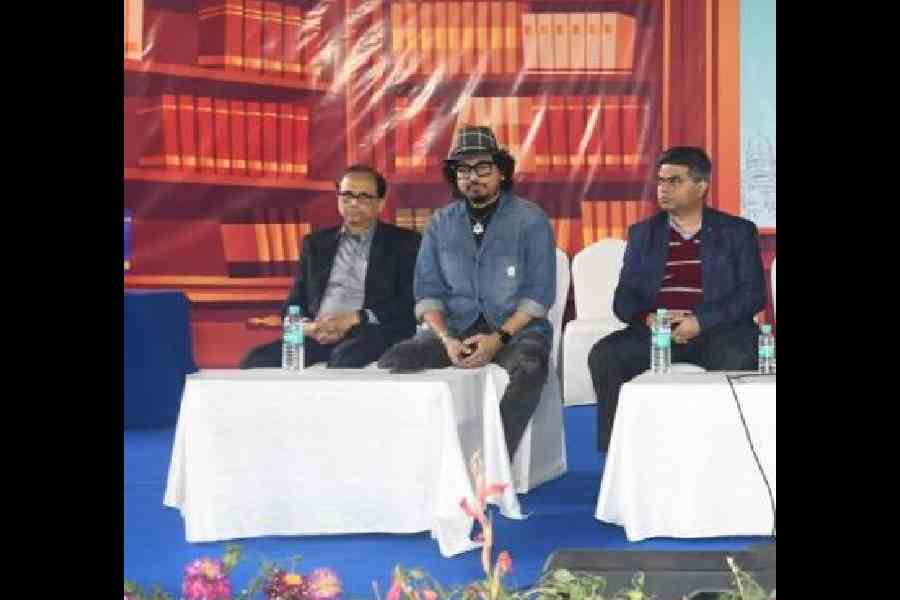Poetry and Allied Art Therapy Foundation organised a discussion titled “Kobita jokhon shrususha, art jokhon therapy” at the 47th International Kolkata Book Fair on January 24. Poetry therapist Shovansundar Bosu initiated the conversation backed by facts and data. He said: “Many people are benefitting from poetry therapy in recent times but unfortunately there is not much noise about it. It is high time we started a public discourse so that more people come forward and try this alternate form of therapy. In the early 1800s, Dr Benjamin Rush first introduced poetry as therapy in a Pennsylvania hospital. Fast-forwarding to recent times, in 2019, experts in Finland studied and validated the effect of poetry on newborns' surface brain activity through the use of EEG. The effect of poetry in stimulating the brain was also acknowledged by Bangor University in Britain's School of Psychology in 2016. This was found to be way more than music due to poetry’s rhythm and expressions. After years of research, we started Poetry and Allied Art Therapy Foundation in 2022. We aim to take the word about individual therapy, group therapy and family therapy to educational institutions, correctional homes, and health institutions and organise workshops, seminars and training and create awareness about poetry therapy as an alternative therapy. It is noted the precuneus and the supramarginal gyrus, two portions of the parietal lobe of the brain get the most activated through poetry. It also leads to the human brain releasing more dopamine. All this can be measured through functional MRI.” He also elucidated the work done by National Association for Poetry Therapy to extend the boundaries and potential of poetry.
Speech therapist Somnath Mukherjee talked about how art, music and poetry connect humans. Music director Indraadip Dasgupta shared his own experience of depression and that it is nothing to be ashamed of. He said: “Few would be aware that social media marketing strategy is based on mood mapping. Companies and marketers assess the best time of the day to push forward their products. Everything has its own time. Coming back to the human mind, Shovansundar’s initiative is highly appreciated. Poetry therapy will be more relevant in the coming days, especially the more we are dependent on technology.”
Neurologist Dr Ansu Sen spoke on how the neural network in the brain multiplies as a result of music therapy with the combined energy of the right rhythm, melody and lyrics. “The left brain processes lyrics and rhythm while the right brain grasps the melody,” he said.

(l-r) Alokananda Roy, Bitasta Ghoshal, Dr Ansu Sen and Agnibha Bandyopadhyay
Psychiatrist Dr Debanjan Pan highlighted how the human brain is used to pattern recognition and poetry acts as a stimulus because of its rhythmic patterns. He also shared how techniques of poetry therapy have been historically used time and again in the clinical practice of modern psychiatry to help people understand their emotions better. Speaking of the receptive form of poetry therapy, one of the major dimensions of the RES model of poetry therapy, he explained: “The therapist would select one poem and present it either in a group setting or to an individual personally and ask the person which part of the poetry they could identify with. In the case of the expressive approach to poetry therapy, the recipient is asked to express through writing their unresolved issues. Symbolic or ceremonial therapy helps if the person is grieving from a separation or a sense of loss has prevailed from a break-up or losing a close one. It is quite easy to say 'move on' after a break-up, but our brain does not really want to move on. We all go through such painful situations in life. Writing a letter to the person who we have lost and expressing our feelings through it would help lessen the mental trauma and agony.”
How does an art form influence us? Dr Pan noted: “Certain parts of our brain get activated while listening to poetry or music and that can be measured scientifically. It has been proven time and again that the brain processes emotion more intensely while perceiving these art forms. They influence and nurture the anterior cingulate cortex of the brain which is responsible for our empathetic side. The stronger the ACC, the more are the chances of us realising our mistakes and being more empathetic in the society.”
Dancer Alokananda Roy shared her delightful experience of rehabilitating prison inmates through dance therapy. She said: “Dance is therapeutic and I felt it almost 15 years back. Today if someone tells me to not perform on stage, I would not feel any grief in it as I would dance in my own company, in my personal space, for myself. For me, dance is liberating. I believe in the phrase “anybody can dance”. One does not have to be a dancer to dance. In my view, poetry is no different from dance as they both aim to achieve the same goal. They are both fascinating phenomena and therapeutic rituals that work on the principle of rhythmic patterns, any break in which is not desirable and needs immediate rectification. Lyrics, taal and sur have an important role to play in these art forms, which ultimately makes us happy and expressive. It’s a shared joy.”






